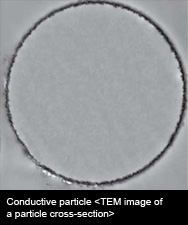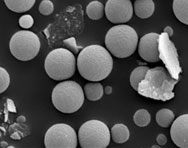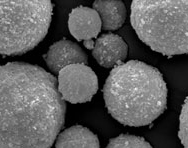We provide modification of particle surfaces in order to contribute more to our customer's product design.
By controlling the particle surface, we can improve product usability and performance.
If you have problems "adapting" to the resins or solvents you use, contact us for a consultation.
We have also developed particles with unique surfaces using our original polymerization technologies.
We can provide hydroxyl groups, carboxyl groups and other functional groups to suit your development needs.
Improved Dispersibility

We can make hydrophobic particles adapt to water by adding functional groups.
In addition, we can also design and propose particles which are compatible with customer formulas for coatings, inks and other products using our accumulated experience and know-how.
- We are able to make coatings distribute uniformly.
- Our products can also provide advanced optical properties.
- This can allow you to achieve stable external appearance and design.

Our conductive particle technology enables coating of the surface of a particle with a laminated film of conductive polymer. As this technology can be used with existing particles, the particle size and particle size distribution can be adjusted freely. In addition, conductive particles formed by this technology are lighter than metal oxide particles, and light transmission can be secured as only the particle surface layer is coated with the polymer film.
Expected Effects- Characteristics of conventional Techpolymer
- Antistatic effect and electromagnetic shielding effect
- Weight reduction
- Various kinds of electric devices
- Electromagnetic shielding materials
- Conductive paint
- Electrode materials, solar battery members, etc.
| Conductive Particle | Electric Conductivity (S/cm) |
| Particle size: 5 µm | 7.9×10-2 |

Particle charge amount can be controlled.
Specifically, the charge can be made positive or negative, and the amount of charge can be adjusted, so the product can be used as an electrical charge limiter and also provide charge storage by using as an additive.
| Resin Structure | Particle Diameter | Form | Charging | Charge Amount (*) |
| Polymethylmethacrylate | 0.1µm | Powder | Positive Charge | +27µC/g |
| 0.3µm | +2µC/g | |||
| Polymethylmethacrylate | 0.1µm | Powder | Negative Charge | - |
| 0.3µm | -21µC/g | |||
| Cross-linked Polymethylmethacrylate | 0.1µm | Powder | Positive Charge | +22µC/g |
| 0.3µm | +7µC/g | |||
| Cross-linked Polymethylmethacrylate | 0.1µm | Powder | Negative Charge | -15µC/g |
| 0.3µm | - |
*The charge amount value was estimated by attaching 3% submicron particles to a 10µm particle as fake toner

We have developed particles for which it is easy to coat the particle surface with inorganic pigments. The particles can be given functions by selecting optimum pigments.
| Example: | Titanium Oxide (Ultraviolet Light Dispersion), Alumina (Light Dispersion) |
PAC-M810

PAC-M810 is a newly developed cosmetic product additive.
By using our company's unique technologies we have succeeded in blending spherical cross-linked PMMA porous particles, which have soft focus properties, with plate-shaped calcium hydrogen phosphate which possesses excellent adhesiveness, we have been able to combine the strong points of both materials into a single product.
PAC-2

This is a composite particle consisting of spherical resin particles with surfaces coated in low-crystallinity hydroxyapatite ultrafine particles.
A composite particle which combines the good usage texture and light dispersion of spherical particles with the adsorption function of hydroxyapatite.
